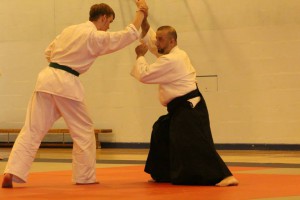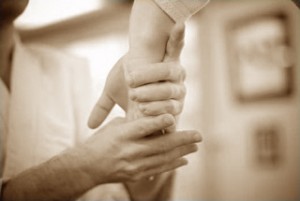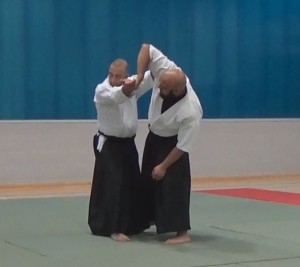Nobody expects the Spanish inquisition by Qaisar Najib
 I was at a class once and one normally looks forward to another instructor teaching a technique. One of the other instructors was given the opportunity to teach a technique.
I was at a class once and one normally looks forward to another instructor teaching a technique. One of the other instructors was given the opportunity to teach a technique.
So we sat quietly, listened and watched this instructor. It’s always good to see a different angle or a different method of doing something. Nobody should limit themselves to one method but learn a variety of angles and views to understand the principles out there.
Questioning when learning is normal. My favourite students are those who question me and my technique.
A version of sankyo was being displayed and taught. I sat intently and listened and watched as this is one of my favourite techniques.
I normally watch the feet, watch the posture and watch the movement and placement of hands. The technique was demonstrated a few times so that we can mimic and try to understand it.
Something was playing on my mind while watching the technique. The elbow of Uke was awfully close to nage’s (in this case the instructor) chin while the technique was being applied. Having practised Muay Thai’ I’m always conscience of an elbow to the face. Having been at the end of one once, it’s not pretty and left me quite unbalanced and at the time quite unaware of what was happening. It was a very good strike and after receiving it, I wanted to learn it in the hope of avoiding it. (My first Jiu jitsu instructor Sensei Raymond Jewell used to say “pain is the best teacher”)
I raised my hand to ask about the elbow. I asked in front of the class in the hope that I could benefit and if anyone else saw it they would benefit from an explanation. My questioning wasn’t rude and in no way was I trying to undermine the instructor; I just wanted to learn. All this was fine; the instructor showed the technique again, and again I asked about the elbow. Maybe I was missing something. Maybe I didn’t understand the technique. The instructor suggested we talk about it while the others got on with the technique, to which I agreed. I was holding up the class.
 We went together in a corner of the mat and I was asked to attack, so I did. The technique was applied on me and again I saw my elbow about an inch away from his jaw. I pointed at it and asked again. The response I got was “I’m taking it easy because we are demonstrating”. That sounded reasonable to me so I asked if he could apply a little more pressure and that I would try to move my elbow towards his face when the opportunity arose. This would satisfy my curiosity if worked and the issue would be fine.
We went together in a corner of the mat and I was asked to attack, so I did. The technique was applied on me and again I saw my elbow about an inch away from his jaw. I pointed at it and asked again. The response I got was “I’m taking it easy because we are demonstrating”. That sounded reasonable to me so I asked if he could apply a little more pressure and that I would try to move my elbow towards his face when the opportunity arose. This would satisfy my curiosity if worked and the issue would be fine.
The technique applied again but this time with a little more vigour. I don’t mind a little pain in the course of training so I was fine with receiving it when applied. My elbow again was close to his face and even though there was pain I found that if I moved my elbow towards his face I had a lot of leeway. I stopped just before his face but demonstrating that I could move it and in fact strike him with it.
Maybe I didn’t understand what he was doing so I asked again for him to explain. The response was something that I learned a lot from that day. “But I’m doing it with ki” came the statement. Now this really got to me because this wasn’t an explanation of the technique. In all honesty I saw it as a copout. If something cannot be explained then say ‘ki’. An apparent force that binds the universe together that can be manipulated and used to one’s advantage. Star Wars references aside, this is a belief that not all people adhere to. So when looking at technique I look at structure, position of the feet and the straightness of posture etc. All of these are measurable and once measured, they can be used, learned and applied. I think this is a topic in itself and will need great thought.
I responded to the instructor saying “but I don’t believe in ki, show me why and how it can work”. Maybe I was getting a little frustrated by now. I was being told just to believe in it and do it because it is a mystical force that he had the ability to use and I had yet to learn.
My persistence in asking him to actually show me how it can work culminated in him walking off and saying “I’m not arguing with a 1st Dan”. He was a 4th dan I think at the time. I do hope he thought about that particular technique after that, for his sake.
That version of sankyo would cause problems yourself. There were others in that organisation that were very proficient and showed on numerous occasions that their technique worked. One in particular was police officer that had used sankyo to great effect against an assailant. So I am not saying sankyo doesn’t work, but that particular view on it seemed flawed in my opinion.
 To teach that to a student as an effective street application of the technique, as was the case that day, was giving a flawed sense of applicability of the technique. If it was stated that this was an exercise, I would have accepted that. The fact of it was that it seemed to be doing the students an injustice.
To teach that to a student as an effective street application of the technique, as was the case that day, was giving a flawed sense of applicability of the technique. If it was stated that this was an exercise, I would have accepted that. The fact of it was that it seemed to be doing the students an injustice.
I learned that day to accept any questions that the students may ask and be open minded about the questions. Beginners don’t know the “script” in aikido.
“Oh sorry was I supposed to fall, do it again this time I will”
In the words from Monty Python
“No one expects the Spanish Inquisition! Our chief weapon is surprise, fear and surprise; two chief weapons, fear, surprise, and ruthless efficiency! Er, among our chief weapons are: fear, surprise, ruthless efficiency, and near fanatical devotion to the Pope! Um, I’ll come in again…”
Your own technique should always be questioned especially by beginners. They may see things that you haven’t and they may have done other arts which you haven’t. Learn to be able to learn, always.
I learned that when asked about a technique I must be able to justify it with answers which are understandable, answers that are in the realm of reality and answers that allow the student and teacher to learn.
Many of my students have asked me questions that have made me think and change my views on certain things. We must always be honest with ourselves, leave any ego at the door and be willing to accept what is right no matter who it comes from.
I started with a Monty Python quote so I think it would be better to end with one that I have slightly changed.
“We are not the instructors who go ‘ki’”
Train well and train hard.

